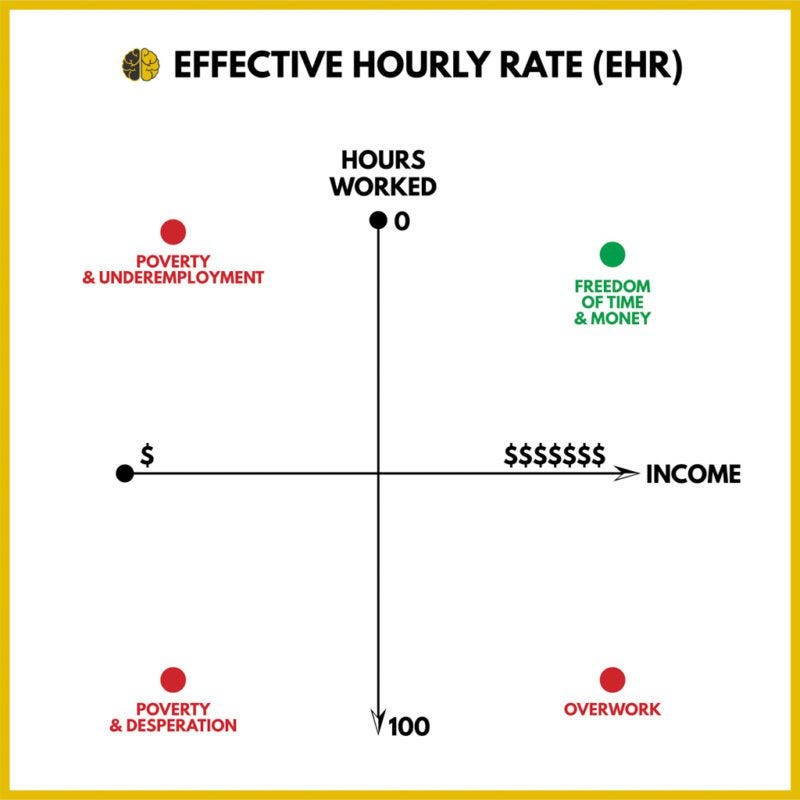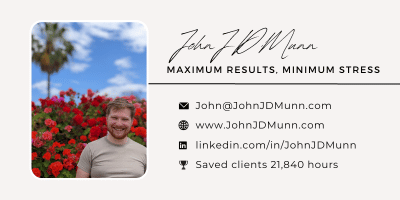🎯 Work Smart Wednesday - February 7, 2024
A simple trick to know when to outsource, pricing problems, and a quote on skill
Work Smart Wednesday
👋 Hey there!
Here is your weekly dose of Work Smart Wednesday
In these emails I will share with you 3 things to help you work smarter in 3 minutes or less. That leaves you with 10,077 more minutes to conquer your goals this week
🎁 Receive rewards for referring your friends 🎁
📩 My favourite template to boost your business (1 referral)
💌 Shout out for you and your business in Work Smart Wednesday (7 referrals)
🎉 A full 1-1 strategy session with me (15 referrals)
1. 💵 How to know when to outsource
Last week when I wrote about the best thing you can buy for your business, the concept of Effective Hourly Rate came up.
Your effective hourly rate (EHR) is how much you earn on average per hour.
As an employee, this is fairly easy to calculate. It is the rate your employer pays you per hour, minus your average necessary costs related to employment (your commute, for example).
As a business owner, it is a little more difficult to get an accurate figure. The easiest way to calculate a rough enough number is how much money you personally draw (take home) per month divided by the number of hours you have worked in that time period.
Knowing this number is more useful than it often seems at first.
As an entrepreneur, you will do a lot of “unpaid” work - such as admin, learning new things, or responding to enquiries. People often forget to factor unpaid work time into their costs, pricing, or even their understanding of how much they make. Many people think they make the $250 per hour they bill, when they actually make $50 an hour after all the necessary additional work.
One of my favourite ways to use my Effective Hourly Rate is to help identify which tasks are worth my time and which I should outsource.
If somebody can do a task 80% as effective as I can but for a fraction of my EHR then they should be doing it instead of me. This helps me to identify key points of leverage, which can then be used to grow efficiently and effectively.
ACTION: Calculate your EHR
Do it right now. It should take 1 minute. Calculate your Effective Hourly Rate. Even if you have done it before, do it again. It is worthwhile tracking your EHR regularly.
EHR = How much you earned divided by how much time you worked to earn it
Ideally, take the figures from real data for over the last year (how much you earned last year vs how many hours you worked).
If you don’t have real data, such as if you haven’t tracked the amount of hours you worked, make an educated guess. It is easier to do this for a shorter time period, such as over the last week or the last month. How much I made last week vs how many hours I think I worked last week.
An estimate right now is worth more than having absolutely no idea.
Guesstimate, then start tracking so you can improve your awareness in the future.
Did it take you longer than 1 minute to calculate your EHR? You will want to improve your income tracking and time tracking.
2. 🔐 Pricing problems: The locksmith paradox
Have you ever been mad at somebody for being good at their job?
It sounds ridiculous, but you probably have. I have. It happens all the time.
Enter: The Locksmith Paradox.
As the locksmith improves at his craft, the customers become increasingly upset by the lower time input required to deliver the service.
The results are the same, but the perception of value changed.
An example of the logic of the Locksmith Paradox is:
It takes you 60 min to do X and customers pay $100 for X
You improve at X, so it now only takes you 30 min to do X. Customers now only want to pay you $50 for X
Same output, but perception of value is 50%. You are penalised for proficiency!
This paradox is particularly evident in service businesses, but causes huge problems for both small and big businesses of all types.
Conventional corporate culture often fixates on input metrics like hours worked, emphasising quantity over quality. I know I have seen countless employees working long hours doing things that make them look busy, rather than any high quality tasks that move things forward.
The root of the problem is simple, a misplaced focus on the input rather than the output.
Time is an input, and a poor indicator of productivity. You’re productive if you achieved your desired outcome, not if you worked 100 hours on that outcome.
We need to divorce the inputs from the outputs, to remove time from our valuations for both us and the customer, to ensure we don’t get trapped in the locksmith paradox.
ACTION: Switch focus to outputs.
As a solo entrepreneur or freelancer, it's beneficial to decouple earnings from hours. Instead of billing clients by the hour, focus on charging based on tangible results and deliverables.
This prevents you from being penalised for finding new sources of leverage that allow you to deliver more more quickly.
As an employer, encourage employees to improve outputs and outcomes. If they finish all their assigned work early, reward them - let them go home sooner, pay them more, whatever. Then focus on further improving outputs. Their time input is borderline irrelevant. Don’t punish people for being efficient.
For everybody: when evaluating whether something is worth paying for, remember to focus on the value you will receive rather than how long it will take the person to give you that value. $100,000 for an hour of somebody’s time can be an amazing deal.
3. 💡 Quote I'm pondering
“It took me a few seconds to draw it, but it took me 34 years to learn how to draw it in a few seconds.” - Paula Scher
Click here to share this quote on Twitter
As I recently explained on LinkedIn, the amount of time it takes you to do something has no bearing on the value you provide.
Time is one of your costs. It factors into your floor price, not your ceiling or target price.
Most entrepreneurs price their products and services based on their costs.
When really, you should price based on the value the customer receives.
That's it! I can't wait to hear what you think. What did you find most useful? What do you want more or less of? Reply to this email now and let me know
I adapted the style this week, with bolded action points. Your feedback would be much appreciated - how do you feel about the change? Email me at John@JohnJDMunn.com
Also, if you have anything interesting to share, I want to know about it😊
Have a great week,
John
P.S. Did someone forward this to you? Subscribe here
P.P.S. Thank you for trusting me with your time. If these emails ever turn into a burden, I encourage you to unsubscribe. I strive to provide real value and I am here to help you to make the most of your time
👋 Want to work together?
When you’re ready, here are 3 ways I can help you:
🔍 Clarity Call - we will discuss your situation and create a step-by-step action plan together so you know exactly what you need to do next for maximum impact
👓 StartSmart - Achieve a 6 figure income within 6 months, whether you only have an idea or you have already started your business
🧘 Overload to Optimal - reduce your workweek to 20 hours or less within 90 days while running your 6-8 figure business
Enjoyed this issue of Work Smart Wednesday?
Refer a friend to sign up and earn valuable rewards







I’m definitely a fan of people charging based on results (value) rather than time.
And yes, many people (maybe all of us) have a knee-jerk reaction sometimes that doesn’t make sense.
I like the way you described it here, John! https://substack.com/@ryanwalsh/note/c-49060155